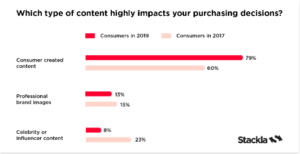The social media content world is an interesting place in 2022. Just browse your feeds for a few minutes for a quick glimpse into what I’m talking about. What do you see? If your feed is like most people’s you’ll notice a ton of:
Branded graphics – Some brands’ entire feeds are made of up these graphics. Sometimes, you’ll notice the graphics include so much type it’s impossible to read on a mobile device.
Stock photography – We’ve all seen this over the years, and we’ve all laughed or scoffed at it. Yet, brands continue to use it regularly in their social content.
Advertising photography – You know the shots. The ones that are obviously being repurposed from a larger ad shoot, or super-staged traditional photography designed for multiple purposes.
This is what we see in our feeds from brands in 2022, right? Yet, most of us realize this is not what most consumers want. And, recent research puts a very fine point on that exact point.
A company called Stackla recently surveyed consumers and marketers in the UK about social content preferences. The study found 92% of marketers believe that most or all of the content they create resonates as authentic with consumers. However, 51% of consumers said less than half of brands create content that resonates as authentic.

That’s a pretty damning stat. But, it goes much deeper than that. When asked which type of content most impacts purchase decisions, consumers had this to say:

Just 13% preferred brand content to a whopping 70% who preferred the far more authentic user-generated content.
Translation: We aren’t listening to or paying attention to our customers.
This is just one study. I’ve seen several in the last year that say essentially the same thing: Brands are giving us brand-focused, staged, stilted content, but what we really want is more authentic, real, here’s-what-we’re-really-all-about content.
Of course, not all brands are failing in this area. Beauty brands, for one, have excelled in leveraging more user-generated content over the last few years. Beauty brand Glossier’s entire Instagram feed is almost made of entirely UGC. However, most brands are still playing by a 2014 playbook. And I really can’t figure out why.
Is it because the Boomers still control decisions and budgets and insist on playing the social content game by pre-internet rules?
Is it because brand governance structures just don’t allow for the risk-taking that more authentic content will bring?
Or is it simply because we don’t want to cede control to creators, influencers and other content generators who may see our brands a bit differently than we do?
All could be possible. In fact, it’s probably a combination of all those things–and more. However, here are some of the relatively easy ideas you could be trying that can get your company to embrace more authentic social content a bit more. I’ve been pushing a few of these ideas with my clients the last few months.
1 – Searching a little harder for user-generated content
I realize user-generated content can be a bit tougher for some brands than others. Sure, beauty and retail brands have thousands of pieces of content to choose from daily. But, what about B2B brands? What about professional services orgs? If you’re struggling to find UGC on the social web, why not work directly with an engaged audience right under your nose? Your employees! Couldn’t you work with a small group of employees and ask them to document their days or experiences with your brand? Whatever they come up with would most likely be a bit more true to the brand than what the marketing team creates.
2 – More *true* behind-the-scenes footage
Behind-the-scenes photography and video has become a cliche. It’s overdone–at least in the way I’ve seen in done the last few years. It’s almost like behind-the-scenes photos and videos have become as rehearsed and staged as the read photo shoot! To capture more authentic behind-the-scenes footage, try this: Ask a member of the social/marketing team to act as a roving reporter at your next event and “hire” them to “cover” the event. There may be a few stumbles. There may be a few mistakes. But that’s the kind of realness customers are looking for. And, it feels decidedly low-risk.
3 – Experimenting with more live and unscripted video
For those who watch Curb Your Enthusiasm, you know Larry David is famous for building entire shows with limited scripts. He will set the scene and provide direction and then ask the actors to improvise the rest of the scene. You could do the same thing with brand video on social networks like Instagram and LinkedIn. Let’s take interviews, for example. Instead of scripting the whole thing, set up the interview and general direction of the topics and then see where it goes from there. It will feel a whole lot less stilted and you’ll probably get better reactions and content from your SMEs as a result.

0 Comments